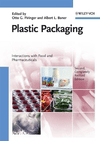Americans continue to recycle more plastic bottles
Domestic processing, import sales of post-consumer plastic bottles increase, exports decline

Plastic bottle recycling grew 120 million pounds in 2013, edging up 4.3%, to top 2.9 billion pounds for the year, according to figures released jointly by the Association of Postconsumer Plastic Recyclers (APR, plasticsrecycling.org) and the American Chemistry Council (ACC, americanchemistry.com). The recycling rate for plastic bottles climbed 0.4% to 30.9% for the year.
The 24th annual National Post-Consumer Plastics Bottle Recycling Report marks the twenty-fourth consecutive year that Americans have increased the pounds of plastic bottles returned for recycling. The pounds of used bottles collected for recycling in the United States has grown each year since the industry survey began in 1990.
Trends in plastics recycling highlighted in the report include:
- Single-stream collection of household recyclables continues to grow, resulting in higher participation rates but also increased contamination
- Use of plastic bottles in packaging applications is expanding but offset by continued lightweighting and increased use of concentrates with smaller, lighter bottles
- Reclaimers are capturing greater value through enhanced sorting operations
- Lack of access to away-from-home recycling continues to be a barrier to increased collection
During 2013, the collection of high-density polyethylene (HDPE, #2) bottles – a category that includes milk jugs and bottles for household cleaners and detergents – rose to 1.05 billion pounds, a gain of over 26 million pounds from 2012. The recycling rate for HDPE bottles remained flat at 31.6%.
Domestic processing of post-consumer plastic bottles is up, according to the report. Exports of post-consumer plastic bottle bales fell from 28.4% to 20.4%, their lowest level in five years. Exports of HDPE, specifically, dropped 19% to 163 million pounds in 2013, while U.S. reclaimers imported 74 million pounds of HDPE, up from 33 million pounds (or 124%) from 2012.
“The data are in, and they clearly show that U.S. reclaimers are able to compete internationally to provide the recycled plastics that our customers demand,” says Steve Alexander, executive director of APR. “America’s plastics recycling industry is growing, vibrant and poised to help brand owners, retailers, and packagers meet their sustainability goals with high quality recycled plastics.”
“Every day, we see more innovative manufacturers using recycled plastics in new and exciting ways,” adds Steve Russell, vice president of plastics for the American Chemistry Council. “Each of us can – and should – help by doing our part to get more used plastics into a recycling bin.”
This year’s survey also found that the collection of polypropylene (PP, #5) bottles rose nearly 32% in a single year to reach 62.0 million pounds. Domestic processing of postconsumer PP bottles jumped 35% to reach nearly 59 million pounds. PP bottles deliberately recycled as PP (instead of blended with HDPE) shot from 34.5 million pounds in 2012 to 44.2 million pounds in 2013. Although PP caps, closures and non-bottle containers are widely collected for recycling in the United States, these data are presented in a separate report on recycling non-bottle rigid plastics, which will be released in the coming weeks (until then see “2012 Rigids Report”).
Together, polyethylene terephthalate (PET, #1) and HDPE bottles continue to make up over 96% of the U.S. market for plastic bottles, with PP comprising half of the remaining 4%. Data on PET recycling referenced in the report were separately funded and published by APR and the National Association for PET Container Resources. A separate report, entitled 2013 Report on Post-Consumer PET Container Recycling Activity, is available on APR’s website.
The 24th annual National Post-Consumer Plastics Bottle Recycling Report is based on a survey of reclaimers conducted by Moore Recycling Associates, Inc.
Looking for a reprint of this article?
From high-res PDFs to custom plaques, order your copy today!








